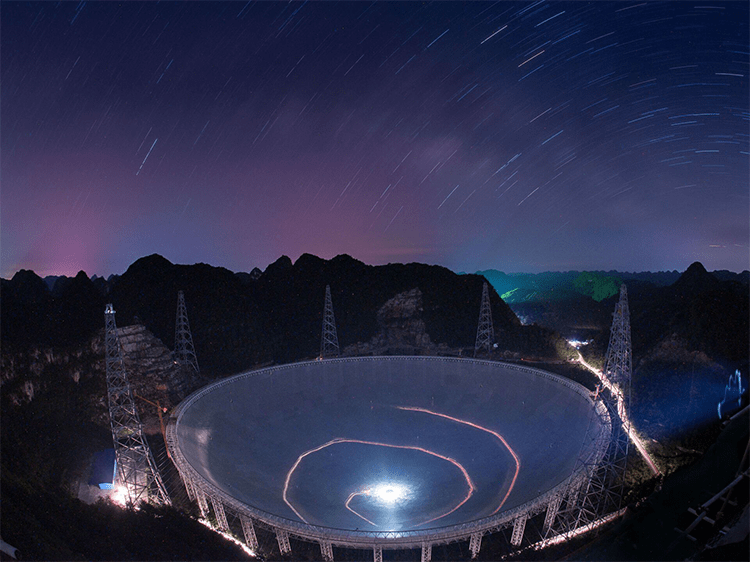China FAST Tour: How to Visit Pingtang’s 500m ‘Sky Eye’ Observatory
Explore China’s FAST: Pingtang’s 500m Sky Eye
Introduction
Deep in the folded karst mountains of Guizhou lies a 500-meter silver bowl cradled by surrounding peaks — a terrestrial ear turned to the cosmos. This is FAST, the Five-hundred-meter Aperture Spherical Telescope, the world’s largest single-dish radio telescope. Without ornate architecture, FAST impresses through the collision of cutting-edge science and untouched nature: by day it gleams like an artifact of an alien civilization; by night it listens silently to radio waves from 13.7 billion light-years away. Visit this ‘silent battlefield’ to feel humanity’s ambition to probe deep space and to witness a miracle born of Guizhou’s land and Chinese engineering.
1. The soul of a national masterpiece: why FAST is unique
FAST is not an ordinary telescope but a super-sized receiver for the universe. Its 500 m spherical reflector — roughly the area of 30 football fields — yields sensitivity about 2.5 times that of the Arecibo Observatory, enabling it to detect the faint ‘heartbeats’ of pulsars billions of light-years away. Choosing Pingtang’s karst sinkhole met strict engineering needs and created a poetic meeting of modern technology and ancient landforms. Since completion in 2016, FAST has discovered over 800 new pulsars and participated in major international astronomical campaigns.
Technical highlight:
The active reflector consists of 4,450 adjustable aluminum panels that can deform to track celestial objects, a transformative approach in radio astronomy.
2. A construction epic across time: from sinkhole to ‘Sky Eye’ over 22 years
This futuristic site is the result of long-term effort. Survey teams spent 12 years inspecting more than 300 karst depressions before choosing Pingtang’s Dawo Dong, a natural funnel formed some 200 million years ago. Its shape, drainage, and electromagnetic quietness were ideal. During construction engineers solved world-class challenges such as ultra-precise large-structure control (errors held below 1 millimeter) and suspension positioning of the 25-meter feed cabin.

Human story:
Local Buyi villagers once called the sinkhole ‘Ma Wodang’, meaning ‘footprint of the immortals’. That legend now resonates with FAST’s mission to search for extraterrestrial signals, a living fusion of ethnic culture and modern science.
3. An immersive astronomy experience: how to get the most from FAST
▸ Must-do experiences
– Viewing ridge: Climb 789 steps (or take the shuttle) to the telescope ridge. The huge reflector unfolds beneath you like a silver ocean, and the 25 m feed cabin floats above — an instant science-fiction panorama.
– Astronomy exhibition center: Interactive VR ‘solar system’ tours, recorded pulsar sounds, and a working scale model of FAST make complex astronomy instantly engaging.
– Night sky sessions: During peak season, guided night programs let you identify constellations with the naked eye while learning the cosmic stories FAST has captured.
Insider tip:
All electronic devices must be stored before entering the core area (including digital cameras). The site offers film camera rentals — a surprisingly popular retro photo option.
4. Where pristine ecology meets technology: an undisturbed karst sanctuary
Thanks to strict radio-quiet protection, a 50 km zone around FAST remains remarkably natural. The 12-bend mountain road to the site is itself a scenic route, with misty terraces and Buyi stilted houses visible along the way. If you have extra time, extend your trip to nearby attractions:
– Pingtang Jiache scenic area: FAST’s watershed protection zone, a green lung of waterfalls and bamboo groves.
– Kedu Astronomy Town: A cluster of space-themed guesthouses and astronomy education bases with extremely low light pollution at night.
5. Practical guide: be a smart visitor to the sky
▸ Transportation
– By car: Drive from Guiyang via the Yinbai Expressway to Pingtang, then county road X948 (about 2.5 hours). Signage is clear.
– By coach: From Guiyang Jinyang Bus Station take the Guiyang–Kedu direct bus (three departures daily, about a 3-hour ride).
▸ Tickets and hours
– Basic ticket: 140 RMB per person (includes shuttle and astronomy exhibition center).
– Opening hours: 08:30–18:00 (extended to 19:00 from April to October).
– Golden rule: Book at least one day in advance via the official WeChat account ‘China FAST Science Center’ — daily visitor numbers are capped at 2,000.
▸ Who should go
– Families: Many interactive exhibits are child-friendly, but the viewing ridge has steep stairs; suitable for children over 6.
– Photographers: Manual film cameras are available to rent; FAST in morning mist offers magical photo opportunities.

Conclusion
Standing on the ridge, looking at a structure that marries human ingenuity and the generosity of the land, you may suddenly understand why scientist Nan Rendong devoted his life to FAST. It is more than an instrument for exploring space — it is an enduring symbol of human curiosity. In this hidden Guizhou valley you will take home two kinds of awe: the vastness of the night sky above and the astonishing creativity beneath your feet. Book your FAST visit and witness Earth and the universe in conversation.


